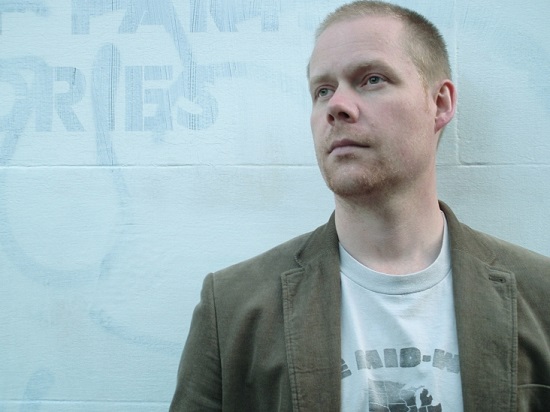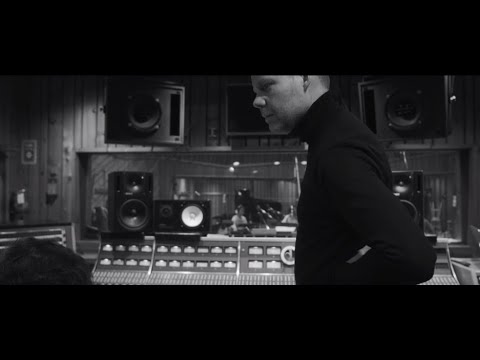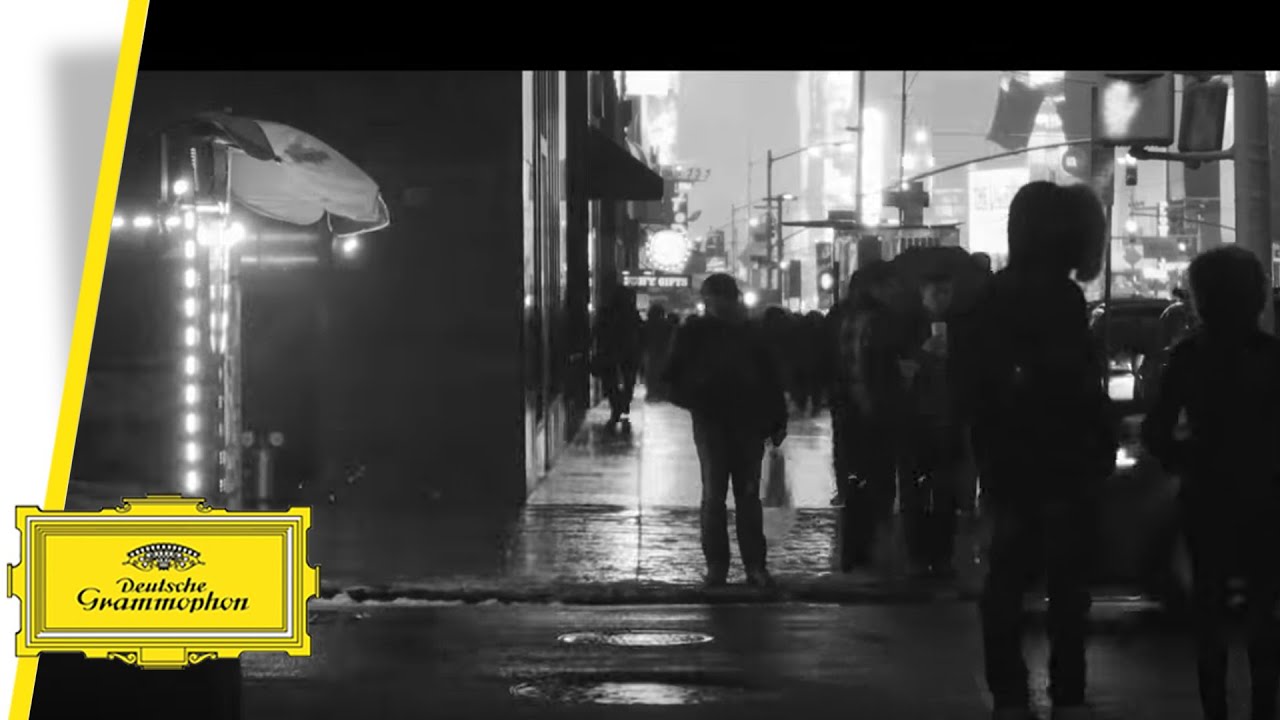Portrait by Yulia Mahr
Contemporary minimalist composer Max Richter has written a new piece entitled Sleep which is eight hours in length and designed to soundtrack a night of slumber.
Richter describes the piece as “an eight-hour personal lullaby for a frenetic world and a manifesto for a slower pace of existence”. The piece is scored for piano, strings, electronics and vocals. It is warm yet haunting and melancholic, while moving at a glacial pace.
The German-born British composer said something during our conversation that stuck with me: “I think time is a preoccupation right now.” This brought a documentary about Marina Abramovic – The Artist Is Present – to mind. The film, released in 2012 chronicles a retrospective at MOMA and features a 736-hour static, silent performance piece, which sees Abramovic sitting immobile in the museum’s atrium during opening hours while spectators were invited to take turns sitting opposite her. As people stared back at her, some for a few minute, some for hours, many began to cry or describe a feeling of transcendence afterwards.
Richter has previously described his music in the terms of story telling but this time, with Sleep, his most ambitious piece to date, it’s like he’s deliberately left pages of the story book blank. It’s as if a projector with no film is beaming a hazy light onto a blank cinema screen for you to project your dreams onto.
I remember reading stories of Aphex Twin going for two to three days without sleep and working in lucid dreaming states during the recording of Selected Ambient Works 2. It got me wondering what was your writing process like for this piece?
Max Ritcher: : I’ve always written at night – my working day for years was around 9pm to 2am – though I do keep more regular hours these days. So in that respect this project was no different from usual. In terms of how the music developed, it was my normal process, which I would say is really a hybrid process of sketching on bits of paper, playing the piano, playing synthesisers, using the computer, staring out of the window, finding things I’d forgotten about, happy accidents, failed plans, best intentions, equipment failures. It is a multidimensional process incorporating a lot of planning and intention and a lot of randomness. Ultimately I just follow the material where it wants to go a lot of the time
What was the recording process like. The players have a very specific mood and atmosphere to hold up, basically a blanket of night.
MR: At the beginning of the sessions it was a bit of a struggle to get down to the right speed and to the right way of thinking about the music and then after a few hours we just kind of got into it. The takes are twenty minutes or something but they just seemed to go by quite quickly, while normally 20 minutes is a hell of a long time in music. So it was interesting the way our focus shifted.
Do you think slow music is harder to record than fast especially for such a quiet piece?
MR: It is in a way because it really focuses everything on the sound and every little note so everything has to be perfect in a way. If there’s loads of material going by you don’t notice the individual things quite so much. Also it really foregrounds the sonic dimensions like electronic ambient music, it’s pushes all of that colour to the foreground so you hear little every atom of sound.
Your piece got me thinking about quiet music. When I worked in a record store any time I started work on an early shift I’d want some ambient or drone music like Labradford, Stars Of The Lid or Grouper. Within minutes I’d feel the shop floor slow down. Some colleagues and customers would comment on how nice and calming it was and others would complain its too depressing and slow and harass me to change the music.
MR: It’s funny. I remember hearing something Dustin O’Halloran from A Winged Victory For The Sullen said on this subject. He claimed ambient music is only for one percent of people. I wondered about that. Is that true? I’m not sure if that’s true really but maybe there is something challenging about it as well. We are used to music trying to grab our attention by being loud. If you look at the way records sound now, this whole thing is about mastering louder and louder and louder. It’s all about attention seeking.
I remember reading about when Brian Eno installed Ambient 1: Music For Airports at the Marine Air Terminal of New York’s LaGuardia Airport it spooked everyone out. I think that underlying sadness to the piece must have got to people in that environment.
MR: Well it is quite a melancholic piece really. He said he came up with the idea in Amsterdam airport. He wanted to make a piece that basically said, “If I die in a plane crash its not a big deal.” So it has a kind of emotionality in it which people overlook sometimes.
You consulted a neuroscientist? Did you discover anything cool or things you could apply to the music?
MR: I did! In a way it’s a good moment for this because there’s lots of research going in neuroscience. There’s lot of talk as to what sleep is and how it works. I spoke with David Eaglemen who I’ve actually worked with before, I did an opera a couple of years ago on a book of his.
We got talking about the various phases of sleep – the dreaming sleep and the various stages of deep sleep. There is also a particular area of sleep called slow-wave sleep. I immediately liked this idea. It turns out this part of sleep is where the brain basically gets into step with itself and gets into this one single phase of these relatively slow brain waves – around 10 Hz or so – and the whole brain ‘fires all at once’. This is a brilliant bit of sleep where we consolidate memory and learning, and memory is one of my obsessions really. It turns out you can promote this state by using music so part of what ‘Sleep’ is about is to try and foster that state which is a very creative brain state. I built things into the music which facilitate that hopefully.
There are lots of soft low end frequencies throughout the piece. I’ve heard low frequencies are triggers for dreaming and brain activity. I know writers often live by the sea because the sound and vibrations from the sea bring about vivid dreams.
MR: It is meant to yeah. I’m obsessed with low end, its kind of my religion. In a way it has given me a chance to explore more than I have in any other project.
Did your concept for an album expand to this length over time?
MR: No it has always been that length. For me this is the eight hour project. We made an hour long listening version of the album, something a bit more manageable for people if they just want to hear the tracks in a compact form but really that’s a side show. the project is the eight hour project.
Was this daunting tackling something on this scale?
MR: I went into it a bit blasé really. [LAUGHS] I didn’t really think it through. But once I got into it I realised eight hours of mixing and recording is a hell of a lot of work. Normally when you’re mixing you say, ‘Let’s try a slightly different EQ on that or let’s bounce the track’ but if you’re doing this long a piece its going to take you two hours to do that which is insane. The logistics of it were really, really hard particularly since it’s mixed down well.
Supposedly this is the longest classical piece ever recorded?
MR: I don’t know about that. I think the marketing department came up with that idea. It makes it sound like some sort of World Record attempt. It’s the least important thing about it. It’s eight and a bit hours long because that’s how long you’re supposed to sleep. There are lots and lots of long classical pieces. There’s Morton Feldman’s string quartet which is about six hours long.
There’s a John Cage piece playing now which is 639 years long.
MR: I read about that. The one playing in a church in Germany? Yeah. There’s a brilliant Wiki page which tells you when the next note is going to be played its quite funny. I think the next one is in the year 2020.
Sleep is such a beautiful idea. I think it’s your best work to date. Do you ever worry the whole concept and length overshadows the music.
MR: I don’t really think about it in that way. I just wanted to make this piece. I only ever really follow the music, that’s what I’m about, I don’t think about it too much. I just wanted to make a piece to sleep through, to sort of explore that sleeping space as a listening space and to have a different encounters between our listening minds or hearing minds and music. I think that’s really interesting. After that I feel I’ve done my job.
Does the speed at which we seem to be living concern you?
MR: There’s a lot of noise going on. I feel one of the big challenges right now is to filter out the things we want to spend our time with mentally. We have to curate our own information space and that’s quite a big deal to do. Sometimes it’s nice to have a holiday. I feel a piece like this offers that opportunity for a little pause from that process. This kind of curation can be so exhausting simply because there are so many possibilities, even if you’re only on Twitter, you still get thousands of messages coming by every day and a lot of them will be interesting. But you’ll still have to make tons and tons of choices and spend so much of day reading all these different messages which will give you tons of reading. So sometimes a pause is a good thing.
Tell me about the premiere of the piece in Berlin.
MR: We’ve got a great venue which is in a disused power station. Downstairs is a club and upstairs is a gigantic concrete chamber which has a natural 20 second reverb. We haven’t done it before. It’s going to be a bit of a voyage of discovery. We’ll play the whole thing start to finish, roughly eight hours or so. Were going to do the show overnight the audience will have beds and they should sleep ideally.
Sleep is released on CD,vinyl download through Deutsche Grammophon on September 4





